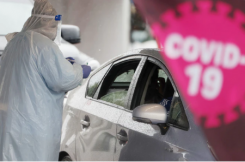Canterbury University working on Covid-19 breath test to replace invasive nose swab
26 February, 2021
This article first appeared on One News.

A nurse administers a Covid-19 test.
A new study led by researchers at the University of Canterbury (UC) has shown a simple breath test may be able to detect Covid-19 in as little as five minutes.
Contributors to the study include UC researchers at the Biomolecular Interaction Centre, along with Callaghan Innovation’s Protein Science and Engineering team as well as MacDiarmid Institute researchers Associate Professor Mark Waterland and Masters student, André Buzas Stowers-Hull, from Massey University.
“We’ve developed a new approach to detecting Covid-19 viral proteins that is sensitive and accurate enough to directly detect coronavirus particles at biologically relevant levels, specifically in breath or saliva samples,” says the paper’s co-author, UC biochemist Associate Professor Deborah Crittenden.
The new scientific paper - "Optical Detection of CoV-SARS-2 Viral Proteins to Sub-Picomolar Concentrations" was published recently in ACS Omega, a journal of the American Chemical Society.
“Unlike other proposed Covid breath-testing technologies, this test directly detects the Covid spike protein antigen and so is expected to be as accurate as the current gold standard lab-based approach,” Crittenden says.
“Over lockdown, we started brainstorming how we could adapt existing biomolecular sensing approaches to detecting Covid. The key insight is that you need a ‘recognition element’ that specifically and selectively binds to part of the virus – in our case, the spike protein.”
“The first thing we tried was part of the ACE2 receptor to which the virus is known to bind but it was too hard to make enough of it. We then discovered a paper in the literature about non-helical DNA sequences that were evolved to bind to the spike protein, and then built them into a range of different sensing systems and tested how well they worked.”
If the test is developed to completion, the test could revolutionise Covid-19 testing, reducing the need for the invasive nasal test and reducing the turnaround time for results and increase the volume of tests that can be performed.


